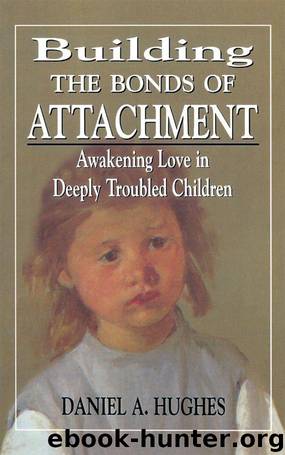Building the Bonds of Attachment by Hughes Daniel A

Author:Hughes, Daniel A. [Hughes, Daniel A.]
Language: eng
Format: epub
Publisher: Jason Aronson, Inc.
Published: 2006-08-07T23:00:00+00:00
COMMENTARY
Katie’s urination on the quilt created the first crisis in her placement. Such incidents are certain to happen in any placement with an unattached child, because such children are experts at sensing what will infuriate their parents. With that awareness, they do not avoid those behaviors, rather they embrace them. They have a compulsion to recreate their early experiences of rejection, abuse, and disgust directed at them from their parents. They need to reexperience that sense of being worthless that such shaming experiences create within them. Feeling worthless affirms the reality of the “hated self” and destroys any reason for trying to form a relationship with Jackie. There could be no way that Jackie could love her. Or, if she had loved her, there could be no way that she would continue to do so once she really saw how bad she was. Katie would put a stop to the placement herself, on her terms, rather than wait for Jackie to do it. That it would end, either through rejecting Jackie or being rejected by her, was inevitable.
Therapy began, as it always did, with Allison talking with Jackie about how Katie was functioning at home. This enabled Allison to know how both Katie and Jackie were doing. After the incident with the quilt it was crucial for Allison to focus on Jackie and her immediate emotional response to what had occurred, as well as her current thoughts and feelings about it. If Jackie was not able to maintain her therapeutic attitude toward Katie, progress would stop and the placement would be in jeopardy. Allison needed to attend to Jackie’s needs if they both were to be able to address Katie’s needs. Allison also valued Jackie for herself, not simply as Katie’s foster parent. She needed to communicate that Jackie’s wellbeing was important to her and her distress would receive her full attention, before turning to Katie. In working to facilitate the attachment between Jackie and Katie, Allison needed to communicate that they were both important to her. Jackie would not be forgotten.
The therapy session at least temporarily derailed Katie’s quest to terminate the placement. Allison had led her, through pacing her affective experiences, from her rage and her resistance to being helped, to her self-rejection and despair. She cried, something that she had not done in years, and she became receptive to the healing and caressing words and touch from Jackie and Allison. In spite of her self-loathing and her distrust of feeling close to others, she felt their comfort and warmth and she could not deny or refuse the experience. But, of course it had to end, and her habitual mode of experiencing herself and others quickly returned. She now felt a compulsion to invalidate what had occurred in therapy and she quickly did so in the car after therapy, and by peeing on the stairs the next morning at home. Jackie’s response of accepting her attempts to sabotage the therapeutic experience, was crucial in preventing Katie from minimizing its validity.
Download
This site does not store any files on its server. We only index and link to content provided by other sites. Please contact the content providers to delete copyright contents if any and email us, we'll remove relevant links or contents immediately.
Rewire Your Anxious Brain by Catherine M. Pittman(18555)
Talking to Strangers by Malcolm Gladwell(13233)
The Art of Thinking Clearly by Rolf Dobelli(10232)
Mindhunter: Inside the FBI's Elite Serial Crime Unit by John E. Douglas & Mark Olshaker(9209)
Becoming Supernatural by Dr. Joe Dispenza(8127)
Change Your Questions, Change Your Life by Marilee Adams(7640)
Nudge - Improving Decisions about Health, Wealth, and Happiness by Thaler Sunstein(7622)
The Road Less Traveled by M. Scott Peck(7524)
The Lost Art of Listening by Michael P. Nichols(7412)
Enlightenment Now: The Case for Reason, Science, Humanism, and Progress by Steven Pinker(7242)
Mastermind: How to Think Like Sherlock Holmes by Maria Konnikova(7233)
Win Bigly by Scott Adams(7097)
The Way of Zen by Alan W. Watts(6512)
Daring Greatly by Brene Brown(6451)
Big Magic: Creative Living Beyond Fear by Elizabeth Gilbert(5616)
Grit by Angela Duckworth(5525)
Ego Is the Enemy by Ryan Holiday(5297)
Men In Love by Nancy Friday(5162)
Altered Sensations by David Pantalony(5048)
